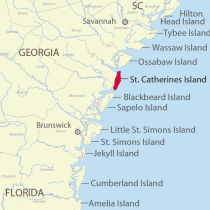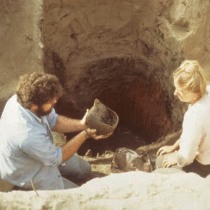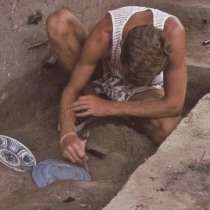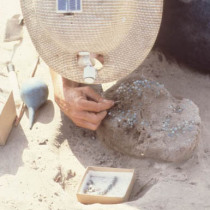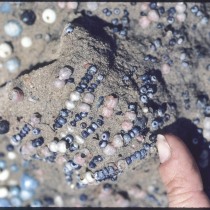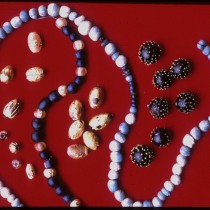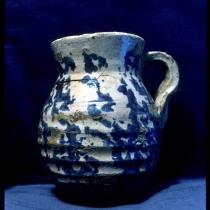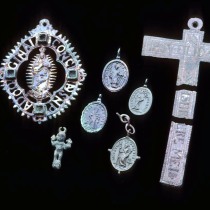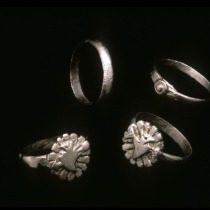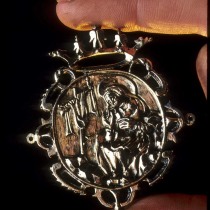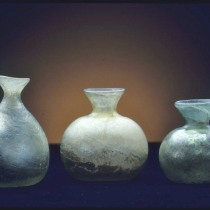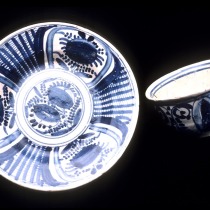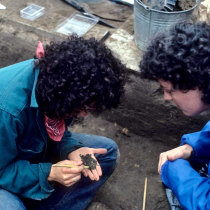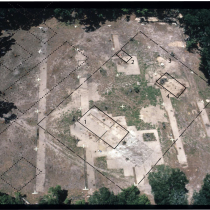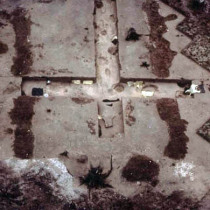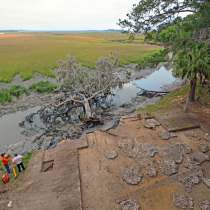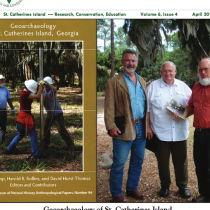It has been said that, since the fall of the Roman Empire, no world power has been faced with so great a need to conquer and hold a vast new territory as the Spanish in the New World.
The Guale Indians living at Mission Santa Catalina and elsewhere along the Georgia coast were among the first indigenous peoples met by Europeans exploring north of Mexico. In 1526, the Spanish made brief contact with this Muskhogean-speaking group, and the French encountered them in 1562–1563. Then, beginning in 1566, the Guale were exposed to a long, intensive period of Spanish colonization.
By 1680, the gradual withdrawal of the Spanish to the south and the correlative southward expansion of the British Carolina colony prompted relocation and reorganization of the vastly reduced Guale population.
St. Catherines Island may (or may not) have been an important settlement during the earliest phase of European contact, but there is no doubt that an important Guale town existed there by at least 1576. Spanish mission efforts were minimal at this point; the year 1584 found only four Franciscan friars throughout all of La Florida, and they spent their time ministering to Spanish needs at St. Augustine in Florida and its sister city of Santa Elena, South Carolina, with little time for missionizing the Guale in Georgia.
The Spanish named the Guale Indians for the chiefdom centered at their principal town on St. Catherines Island; the associated Franciscan mission eventually became known as Santa Catalina de Guale. By 1597, a decade after the abandonment of Santa Elena, 14 friars were stationed in La Florida, and several of these arrived in Guale. That year, the Indians of Guale staged a major revolt that partly played out on St. Catherines Island. The uprising once thought to have distinctly nativistic overtones due to the killings of two friars on St. Catherines is now thought to have resulted from a rivalry between competing chiefdoms, with the friars caught in the middle. These friars are currently up for sainthood in the Vatican through the Cause of the Georgia Martyrs.
For a time, the missions were abandoned, but were resettled in the early 17th century. Spanish hegemony remained unchallenged until 1670, with the English establishment of Charles Towne, South Carolina and brought down a slave raid to St. Catherines, the northernmost outpost of the Spanish Empire on the east coast of North America.
Spanish missions on the barrier islands of coastal Georgia became the first victims in the so-called conflict over the “debatable land.” After the Spanish launched an unsuccessful expedition to attack and destroy Charles Towne, which was the southernmost British settlement, the British retaliated with force, steadily pushing down the coast and across the interior toward the Mississippi River.
In 1680, the British forces attacked the fortified mission at Santa Catalina, which was defended by a small and hastily organized band of Spaniards and Guale Indians. Although the Guale successfully held off the invaders, they were horrified by the attack, and St. Catherines Island was soon abandoned. British travelers in 1687 and 1738 described the ruins of Santa Catalina, but the mission site was “lost” soon thereafter.
Three hundred years after Santa Catalina disappeared, a team of archaeologists from the American Museum of Natural History spent five years finding Mission Santa Catalina de Guale, Georgia’s most important Spanish settlement. Based on 10 years of controlled survey sampling, archaeologists knew that 16th- and 17th-century Spanish-period ceramics occurred at only five of the 135 surveyed archaeological sites, clustered along the western marshes of the island. They continued narrowing down the search area through a series of remote-sensing techniques, hitting the mission well with their first test pit! But, it took another two decades of excavations to unearth the structure of the mission and the 2 million artifacts contained therein.
Excavations at the mission ceased in 2000, though rapid erosion of the western scarp of the island, which had been a stable surface for the past 5000 years, caused concern among archaeologists and climate change scientists. At the current unprecedented rate of erosion, this significant settlement with the oldest Catholic church in North America may disappear in fewer than 100 years.
Mission Santa Catalina de Guale, one of many founded in the 16th century, consisted of a central group of structures including a church (iglesia, 1) , a residence (convento, 4), and a communal kitchen (cocina, 2), laid out along a rigid grid pattern. Excavations at the site revealed the layout of the sacred compound, consisting of a rectangular plaza flanked by the mission church and the friary.
Inside the convento were the refectory, cells, offices, and workshops. The kitchen and granary were separate buildings. Since 2000, excavations have partially unearthed the pueblo, or native village, adjacent to the mission. It seems likely that housing in the pueblo at Santa Catalina consisted of rectangular buildings, perhaps separated by streets.
Related Publications
Geoarchaeology of St. Catherines Island, Georgia
The field of geoarchaeology has typically been defined as either geology pursued within an archaeological framework or sometime the reverse, as archaeology framed with the help of geological methodology. Either way, the formalized objectives of geoarchaeology define a broad range of pursuits, from placing archaeological sites into relative and absolute temporal context through the application of stratigraphic principles and absolute dating techniques, to understanding the natural processes of site formation, to reconstructing the landscapes that existed around a site or group of sites at the time of occupation.
- Date Published : April 2011
- Read more
25th Annual Christmas Bird Count, December 17th, 2011
On Friday, December 16th, 42 birders hopped on boats at the mainland eager to get to St. Catherines and check out their assigned areas in preparation for Saturday, the 25th Christmas Bird Count (CBC) on SCI. This is part of The National Audubon Society’s 112th CBC, with the count taking place in over 2,000 locations from December 14th—January 5th.
This year was our third best count with 140 species and 33,383 individuals on count day. Four additional species were seen during count week, and the total of 144 matched (with 2002) the highest number during count-week.
- Date Published : January 2012
- Read more
After 30 Years of Animal Research, Bronx Zoo to Close Island Preserve
The Bronx Zoo has closed a large animal preserve on a 14,000-acre undeveloped island off the coast of Georgia, where for 30 years zoologists have studied – among other things – the mating habits of wildlife, including lemurs, hartebeests, zebras, tortoises, gazelles and several species of exotic birds.
- Source : The New York Times
- Date Published : December 29, 2004
- Read more
Lemurs, hartebeests, hornbills call island home
In the interior of St. Catherines Island, deer roam freely and wild hogs jog playfully throughout the woods. Suddenly, in the distance, a sound not native to the area is heard. A group of ring-tailed lemurs hangs from the trees, a small herd of African Jackson hartebeests prances by, and an exotic great hornbill bird is spotted. Welcome to the sanctuary of St. Catherines Island Wildlife Survival Center.
- Source : The Coastal Courier
- Date Published : June 8, 2009
- Read more
The Saint behind St. Catherines Island
Do you ever wonder where St. Catherines Island got its name? Recent research on artifacts recovered at Mission Santa Catalina de Guale, located on St. Catherines Island, has provided some insight into this very question. Ironically, the information regarding the name source comes to us from an object recovered on Amelia Island (Florida). There are actually four Santa Catalina de Guale missions in Spanish Florida. The earliest (Santa Catalina de Guale I), built on St. Catherines Island, was attacked in 1680 by British troops and Indian allies, probably in a slave raid. After the attack, the residents relocated to nearby Sapelo Island, establishing the second location of Mission Santa Catalina (II, 1680–1683).
- Date Published : April 2012
- Read more
Recent History of the North Pasture
Most of the Gopher Tortoises on St. Catherines Island live in North Pasture. Some have formed colonies on other parts of SCI only to return to North Pasture after a few years. Some people call North Pasture (NP) the “North Savanna”. Some have described it as a Long-leaf Pine Flat-wood and another as a managed Long-leaf Pine forest. It was Georgia’s largest stand of mature LL pine on a barrier island when the logging began (1938). Mr. Noble purchased the island in 1943. At that time loggers held timber contracts for most of the remaining timber on SCI.
- Date Published : April 2013
- Read more
Throughfall and Stemflow in the Forest Canopy
Forests provide many known ecosystem services— they clean our air, sequester our carbon emissions, protect our soils from erosion, provide habitat for species on which we rely for sport and ecotourism, and much more. While the list goes on, there are likely even more ecosystem services which have yet to be discovered. What other amazing services do forests provide to our ecosystem? That’s the question at the heart of Dr. John Van Stan’s (Fig. 1) research on St. Catherines Island. To begin answering this question, Dr. Van Stan is currently installing monitoring equipment that will allow him and his colleagues at Georgia Southern University, Skidaway Institute of Oceanography, and the Helmholtz Centre for Environmental Research (in Leipzig, Germany) to track water and nutrients as they move from the canopy into the soils and freshwater lens and, ultimately, out to the ocean. They expect to find new forest influences over each of these ecosystem components critical to barrier islands as a whole.
- Date Published : August 2012
- Read more
Survey of St. Catherines Island’s Aquatic Beetles
Students of the department of Biological and Environmental Sciences at Georgia College reveled in the opportunity to explore St. Catherines Island and its aquatic fauna with me. These students (from five countries) are currently participating in classes, including Entomology, Aquatic Entomology, and Invertebrate Zoology as well as independent research. Most of the students come fully trained with collecting and curating techniques of invertebrates and particularly beetles, and are already quite adept for our task of collecting and analyzing beetles of SCI.
- Date Published : December 2012
- Read more
Southeastern American Kestrels
In January 2012, St. Catherines Island hosted the 1st Southeastern American Kestrel Working Group meeting, led by Ken Meyer of Avian Conservation and Research Institute (ACRI). This meeting was a culmination of a planning project being facilitated by ACRI with a National Fish and Wildlife Foundation grant to understand the status of and concerns for the SE American Kestrel. Florida, Mississippi, Alabama, and Georgia state and federal personnel attended to report the status of the birds in their area, and to identify needs that each state has to learn more about the status of these Kestrels and understanding their limiting resources. Coming together as a cooperative working group gives biologists and land managers a better understanding of large-scale needs and resources of this species and their habitats.
- Date Published : February 2012
- Read more

